Travel
These 10 Airports Get More Foot Traffic Than Most Museums. But Which Ones Have the Best Art?
We surveyed the art landscape at 10 airports around the United States.
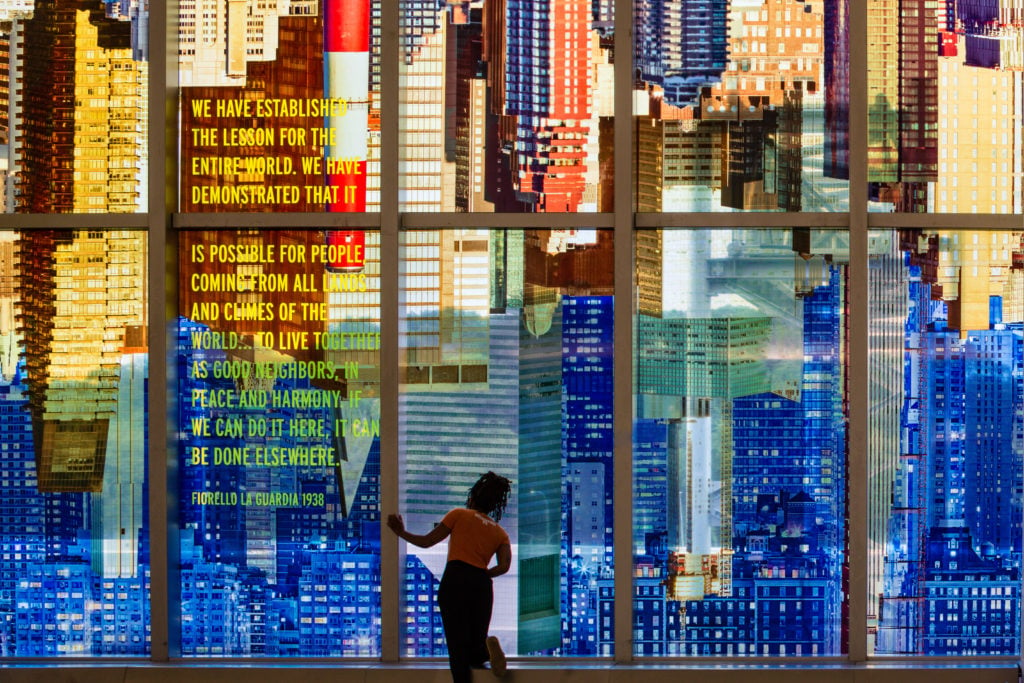
We surveyed the art landscape at 10 airports around the United States.

Adam Schrader

Airports are places of chaos and calm, where the young leave for college or the military, and CEOs return home from important business trips. They are places through which grandparents travel to see their grandchildren and long-distance couples to meet their partners.
They are places of emotion and expression, where the best and worst of humanity can be seen, which is likely why airports spend tens of millions on incorporating large-scale sculptures and other public art.
After all the stress of getting to the airport and through security on time, the last thing on anyone’s mind is stopping to admire the art and design in the transit hubs—yet the market for airport art is booming.
In fact, the recent $8 billion redesign of LaGuardia Airport in New York City was admired with headlines from “Ready When You Are, Terminal C Is Now an Art Destination” in The New York Times to “Go to La Guardia Airport for the Art” in Curbed.
Here, we compile a list of art in ten major U.S. airports, highlighting main attractions and noting other works and exhibits at each location. Though not exhaustive, this list shows the most-seen pieces of art at airports in the United States, which attract more foot traffic than many of the world’s top museums.
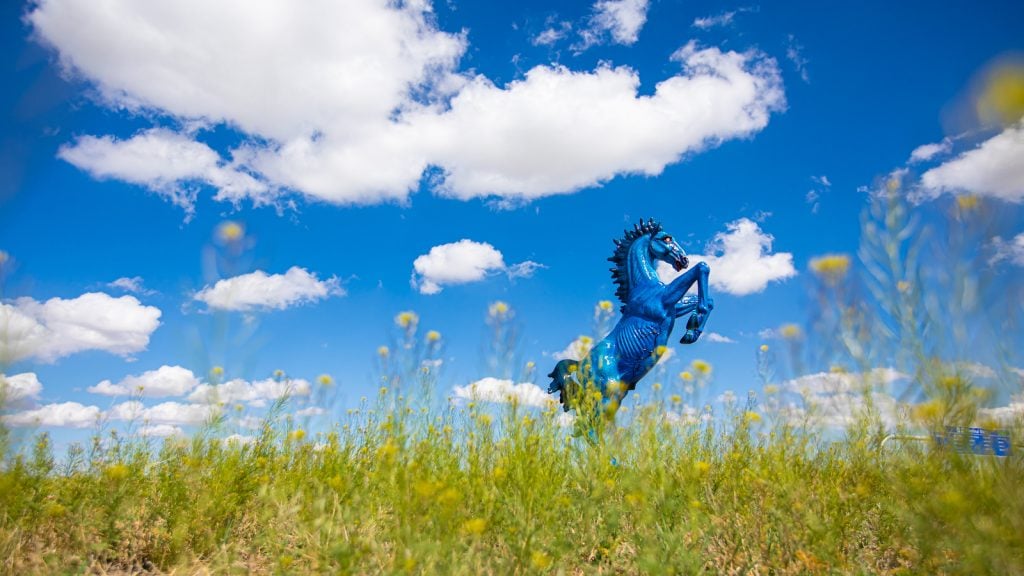
Luis Jimenez, Mustang (2006). Photo: Courtesy of Denver International Airport.
Main attraction: Mustang by Luis Jimenez (2006)
Description of airport offerings: This 32-foot cast-fiberglass sculpture features a galactic blue mustang rearing, with a dark mane and eyes that glow with the light of the day. The horse is bolted into a concrete base in the median of Pena Boulevard leading up to the terminal and was created by Luis Jiménez, who died in 2006 as the work was being moved from his studio. The sculpture was finished by the artist’s sons Adan and Orion.
Mustang was commissioned by the airport and was in the works for almost a decade before his death. Jimenez, who was of Mexican descent, was born in El Paso, Texas, and found success as an artist in New Mexico—pushing against minimalism at the time with work considered to have contributed to the rise of pop art in the 1960s. As described by the Denver International Airport, Mustang showed how the artist’s style referenced “the grandeur of the Mexican muralists” and “the energy of the Southwest.” Denver International Airport boasts an extensive list of past exhibits that highlight the work of local artists and make the airport a destination for the art enthusiast beyond Jimenez’ work.
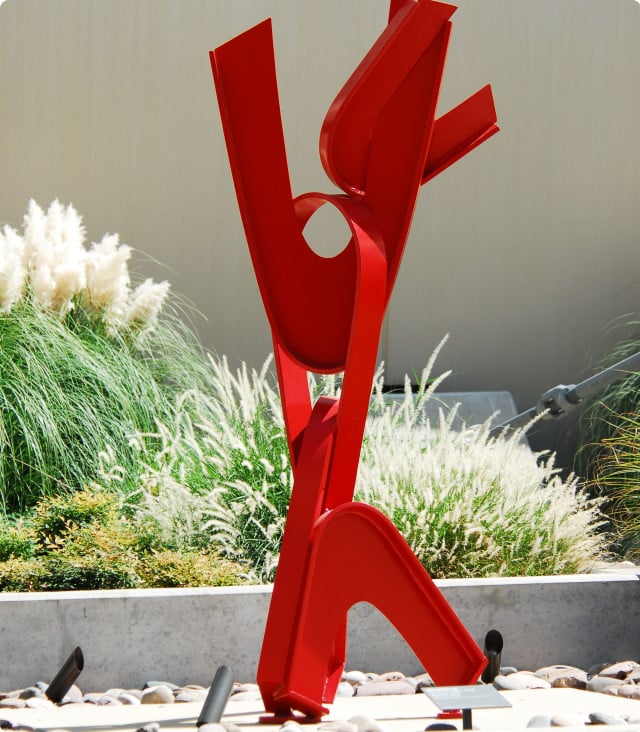
Mac Whitney, Chicota (2001). Photo: Courtesy of DFW Airport.
Main attraction: Nasher Sculpture Garden
Description of airport offerings: Dallas-Fort Worth International Airport benefits from being in the center of the excellent museums in both major cities. Fort Worth boasts institutions including the Kimbell Art Museum and Amon Carter Museum of American Art while Dallas claims the Nasher Sculpture Center. Voyagers traveling through DFW Airport can experience a mini Nasher Sculpture Center without risking missing their flight. The Nasher Sculpture Garden is located at the lower curbside level outside of Terminal D and features three large sculptures.
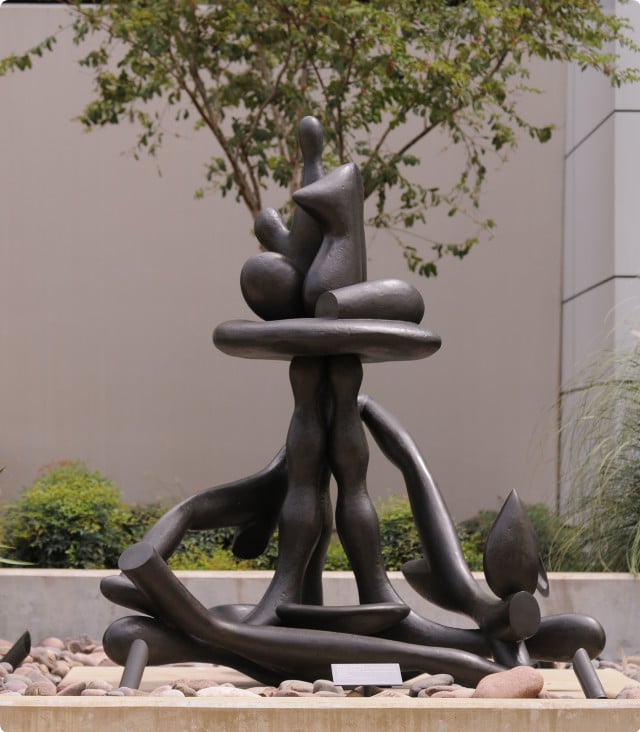
Isaac Witkin, Hawthorne Tree, Variation III (1990). Photo: Courtesy of DFW Airport
Mac Whitney’s nine-foot-tall Chicota (2001) was described by the airport as “interlocking V-shapes of earlier sculptures combined with a loop or closed ribbon of steel.” John Newman’s Torus Orbicularis (1988) shows the artist’s interest in the mathematics of topology and “suggests biological forms like flowers, exoskeletons, fossils and shells.” Isaac Witkin’s Hawthorne Tree, Variation III (1990) was described by the airport as having been made during a “particularly innovative” phase in the artist’s career and is on loan from the artist’s daughter.
Inside the airport, there are an additional six large-scale sculptures—all in Terminal D. Terry Allen’s Wish (2005) is a giant replica of a wishbone while Crystal Mountain (2005) by Dennis Oppenheim is perhaps the largest piece of art at the transit hub with the incredible dimensions of 30 feet by 45 feet. “The Dallas/Fort Worth Airport International Terminal project is interesting to me because of the innate relationship to movement and human experience of space as it is traversed,” Oppenheim said in a statement on the airport’s website. Like Denver airport, DFW can be seen as a destination in and of itself for art lovers.
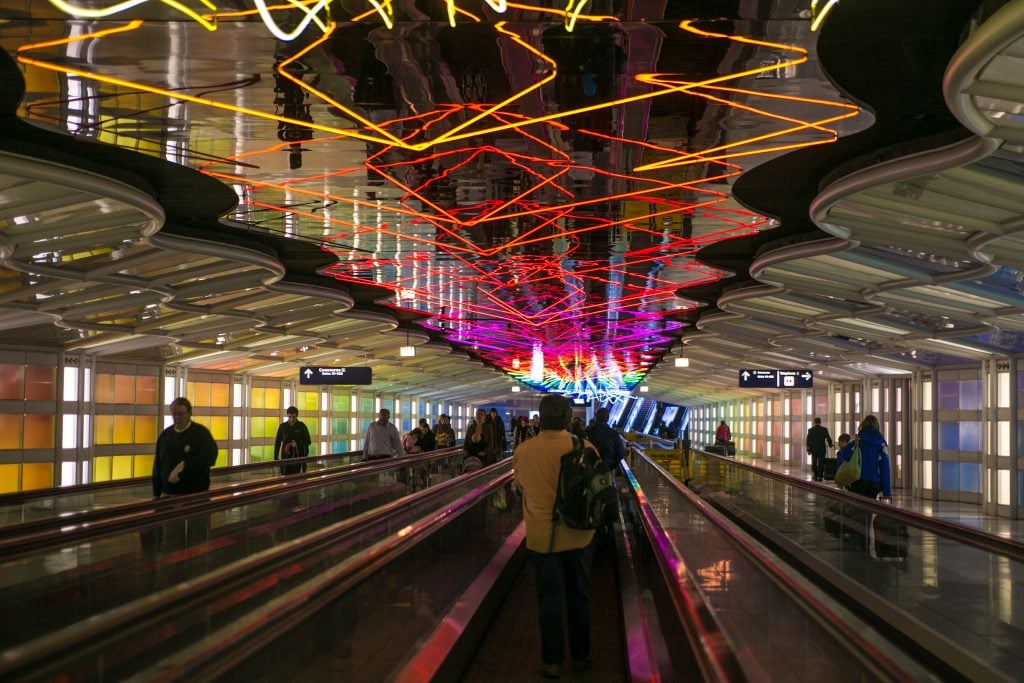
Travelers move through a colorful public art installation in Terminal 1 at O’Hare International Airport entitled Sky’s The Limit by Michael Hayden on March 27, 2013, in Chicago, Illinois. Photo: George Rose/Getty Images.
Main attraction: Sky’s the Limit (1987) by Michael Hayden
Description of airport offerings: Hayden’s installation is a 745-foot-long, subterranean kinetic light sculpture composed of 466 neon tubes, according to the airport’s website. The sculpture includes 23,600 square feet of mirrors reflecting over one mile of neon and is located in the tunnel connecting Concourses B and C of Terminal 1. According to Hayden, the piece was installed at the airport in 1987 and cost $1.2 million at the time. Now Instagram-bait, the neon tubes provide about 80 different hues that progress from cool to warm at the tunnel’s two ends.
While at O’Hare, you can see a skeleton model of a Brachiosaurus dinosaur excavated in 1900 by the Field Museum paleontologist Elmer Riggs in Terminal 1, near the entrance to the Sky’s the Limit tunnel. The model stands four stories high and was given to the airport in 1999. The airport also boasts a mosaic donated from Chicago’s sister city Amman in Jordan in Terminal 5. The mosaic, titled Treasury of Petra and created by Sonia Twal, was inspired by the city of Petra in the Jordanian desert and the materials were sourced from the Petra region.
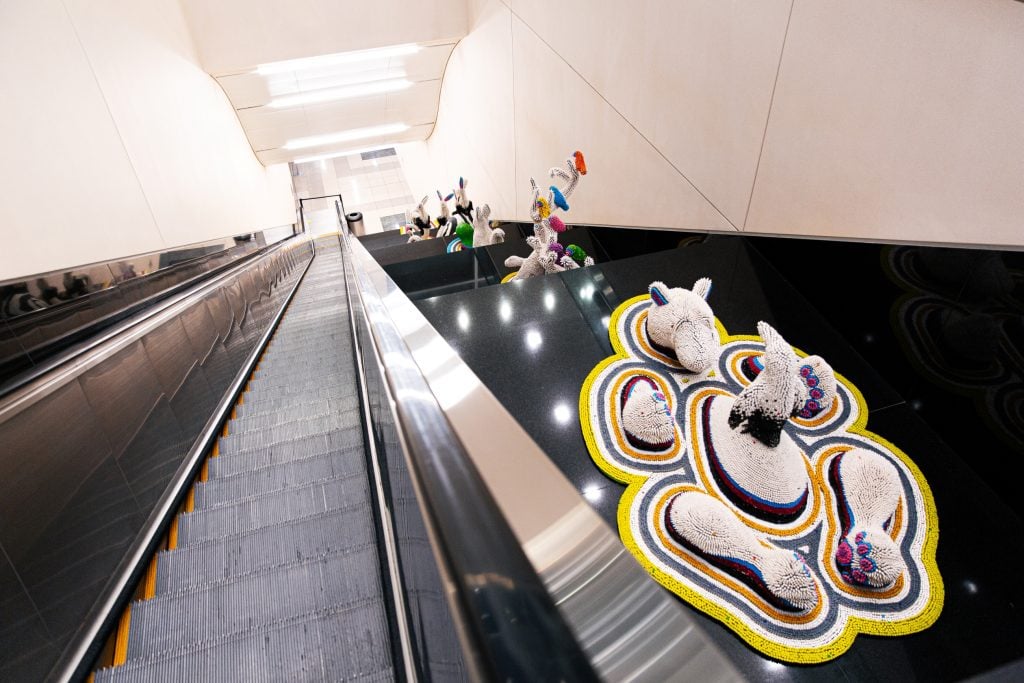
Herb Williams, Ripple (2022). Photo: Courtesy of John Brown.
Main attraction: Ripple (2022) by Herb Williams
Description of airport offerings: Before getting into Williams’ work, it is important to note that the Atlanta airport has an entire exhibit dedicated to the late Rep. John Lewis. The exhibit, titled Good Trouble, is located on the east side of the domestic terminal and includes videos, photos and artifacts from the life of the civil rights icon. The artifacts include the pen that President Lyndon B. Johnson used to sign the Civil Rights Act which he then gave to Lewis. The history-focused airport also has a tribute wall to Martin Luther King, Jr., an exhibit about Atlanta history and an exhibit of stone sculptures from Zimbabwe’s best-known artists.
However, the current main attraction for art lovers is a series of six sculptures called Ripple that emerge from black granite plinths along the escalator to Concourse D. The installation was made using 500,000 Crayola crayons. Williams spent more than two years creating the piece. “The sculpture at the top of two narwhals carrying a three-toed sloth was a dramatic Iwo Jima flag raising kind of installation threading the tooth that the sloth was welded to,” Williams said on Instagram. “If you ever fly through Atlanta I hope you enjoy the artworks.”
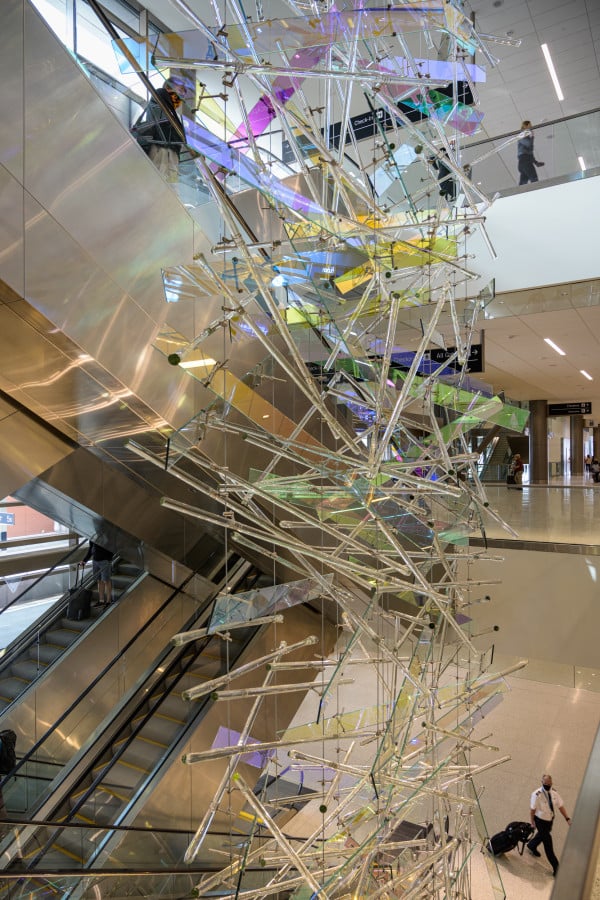
Gordon Huether, The Falls (2020). Photo: Courtesy of SLC International Airport and Gordon Huether.
Main attractions: The Falls (2020) and The Canyon (2020) by Gordon Huether
Description of airport offerings: Salt Lake City International Airport boasts two large-scale installations and other works by Gordon Huether, The Canyon and The Falls (2020), which can be seen as companion pieces inspired by Utah’s natural landscape. Huether’s The Falls is a 65-foot-tall sculpture made from glass and Pyrex rods, and dichroic glass fins and weighs 5,000 pounds. It is placed at the entrance to the airport’s main terminal. “The suspended sculpture makes use of the natural light this location receives by partnering colorful, light-sensitive dichroic glass panels with light refracting glass rods to create an astonishing array of ever-changing colors and patterns on adjacent surfaces,” Huether wrote on his website.
Meanwhile, The Canyon is made from aluminum tubing and fabric that runs horizontally and mimics the canyon-shaped architectural design of the terminal. The airport also features several other artwork and murals, including the beloved Flying Machines by artist Dennis Smith which were in airport before its recent massive redesign. The giant mobiles were restored at the artist’s studio and returned to the redesigned airport.
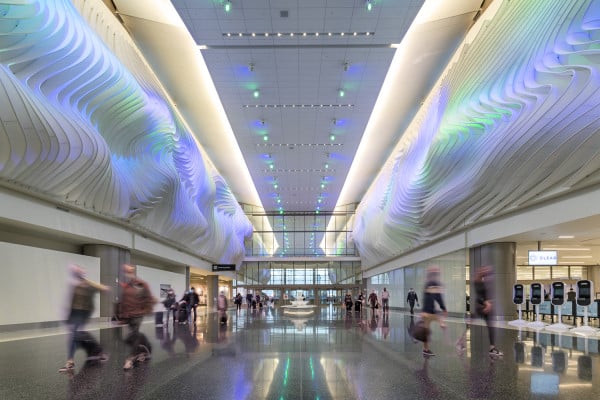
Gordon Huether, The Canyon (2020). Photo: Courtesy of SLC International Airport and Gordon Huether.
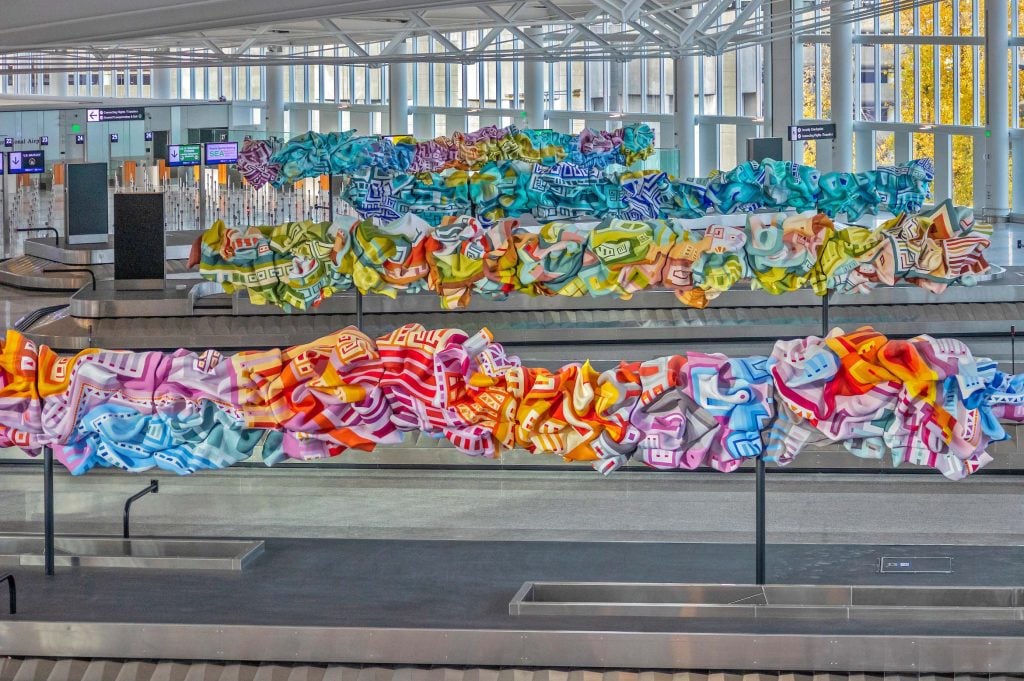
Marela Zacarias, Chalchiuhtlicue (2020). Photo: Courtesy of Port of Seattle
Main attraction: Chalchiuhtlicue (2020) by Marela Zacarías
Description of airport offerings: The work Chalchiuhtlicue at Sea-Tac is an installation of five sculptures that comprise a single piece and made from joint compound, wire mesh and acrylic. Zacarías said in an artist statement on the airport’s website that the piece, the colors of which were inspired by her nature walks around the city, took 20 months to build and was constructed at a temporary studio in Seattle. “I think of these sculptures as if they were made out of water because water reflects its environment and the colors around it,” she said. Zacarías said the work references locations in the region including the Duwamish River, Olympic Peninsula, La Push, Ruby Beach, Hoh Rain Forest, the Puget Sound and Lake Washington. Zacarías, from Mexico, has experience as a muralist which shows in her work.
The airport also has a photorealistic, mural-sized painting titled High Wire (1993) by Michael Fajans made from 11 panels of acrylic on plywood that depicts a magician and his assistant performing a magic trick. The airport has described it as the piece of art in its collection “with the most debate attached” and said, “a good piece of art will always get people talking.” Meanwhile, Sea-Tac also boasts seemingly one of the only pieces of stained glass window art at any airport. The massive 91-foot-wide work, titled I Was Dreaming of Spirit Animals (2003) by Cappy Thompson, depicts a cosmogenic scene in which the sun and moon are traveling in a pegasus-drawn cart while dropping flowers and pouring out water onto the Earth as two people are seen sleeping in their bed at home. The artistic style of the work seems inspired by Medieval art and gives the terminal the feel of a cathedral.
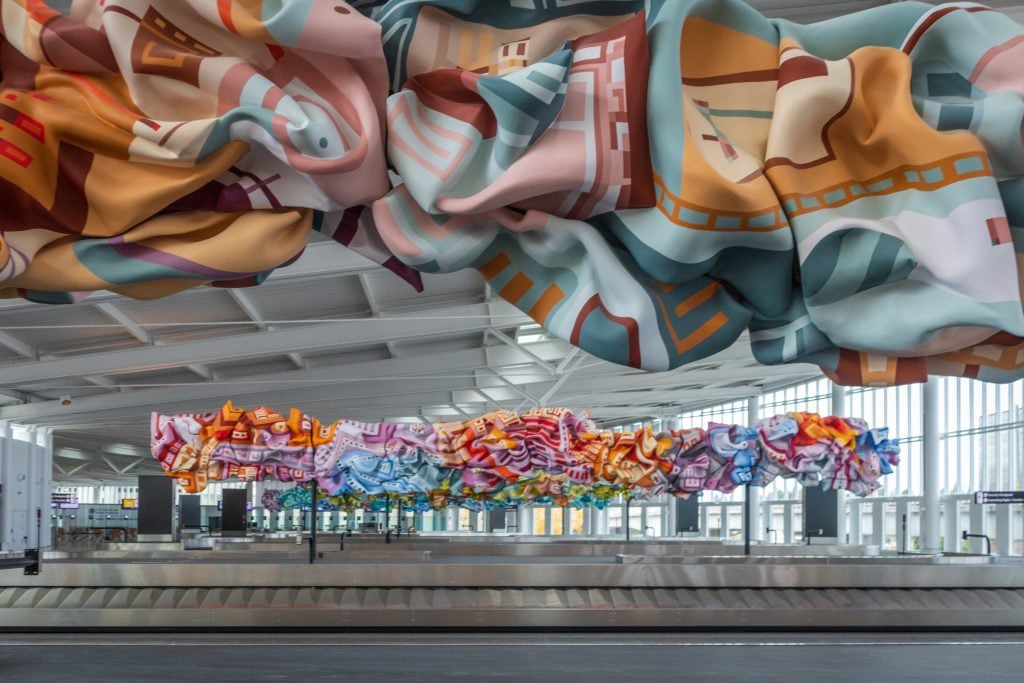
Marela Zacarias, Chalchiuhtlicue (2020). Photo: Courtesy of Port of Seattle.
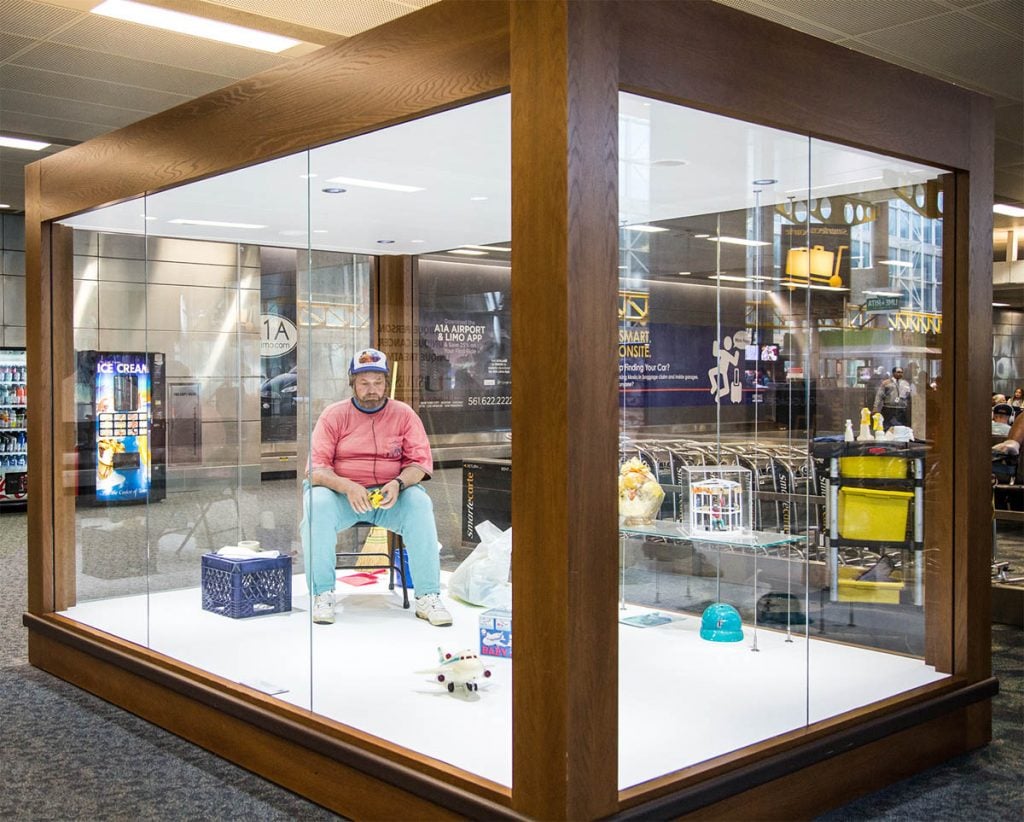
Duane Hanson, Vendor With Walkman. Photo: Courtesy of Broward County Cultural Division.
Main attraction: Vendor With Walkman (1990) by Duane Hanson
Description of airport offerings: This installation, located at the departure level of Terminal 3, features a man believed to be in his 30s wearing a red T-shirt, blue pants and a baseball cap while listening to a cassette player during a supposed work break in what the airport called a “slice of Americana.” The artist, Duane Hanson, spent most of his career in South Florida and was known for his life-sized realistic sculptures of people made using materials including polyester resin, fiberglass, Bondo and bronze. The Miami Herald did a profile in the work in 2021 describing it as the airport’s “most popular vendor.” The newspaper revealed that Hanson was paid $170,000 for the work.
Hanson also made The Traveler, exhibited at Orlando International Airport, and Football Player, exhibited at Miami International Airport. But Vendor With Walkman is of particular intrigue, earning Fort Lauderdale its place on this list.
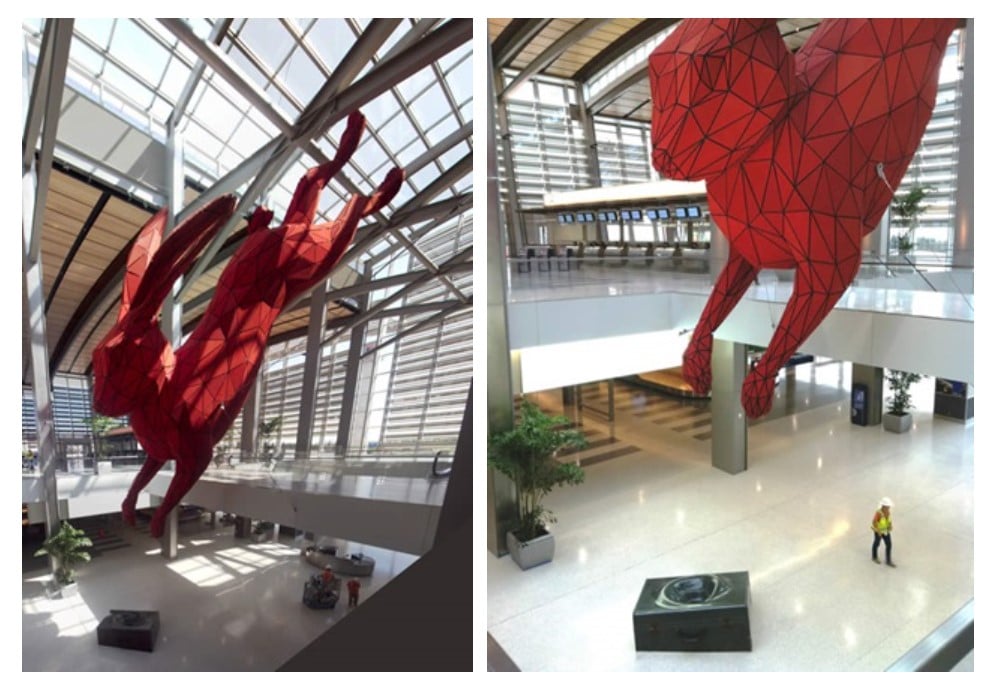
Lawrence Argent, Leap (2011). Photos: Courtesy of City of Sacramento.
Main attraction: Leap (2011) by Lawrence Argent
Description of airport offerings: This giant sculpture of a geometric red rabbit leaping in a downward direction has massive dimensions of 56 feet long and 19 feet tall. It is made from aluminum and suspended from the ceiling with “invisible” cables to give it the appearance of being frozen in mid-air. “A rabbit appears to have lept through the glass from the green space on the south side of the terminal and is diving into a suitcase that appears to have a liquid vortex opening on the top which is situated on the floor of baggage claim,” city officials said in describing the work.
Officials said the rabbit was selected because it is a symbol for “cleverness, foolishness, of femininity and androgyny, of cowardice and courage.” Meanwhile, like DFW, the airport has another sculpture by Dennis Oppenheim. The work, titled Flying Gardens, depicts 12 massive bird sculptures mounted at varying heights along the airport-facing façade of the Parking Garage and in the landscaped area near Terminal A. The airport has several other pieces of art throughout its facilities and was chosen over the nearby San Francisco International Airport because of the interest in Leap. However, SFO does boast an entire institution—the SFO Museum—with perhaps the most extensive collection of art at any airport in the United States.
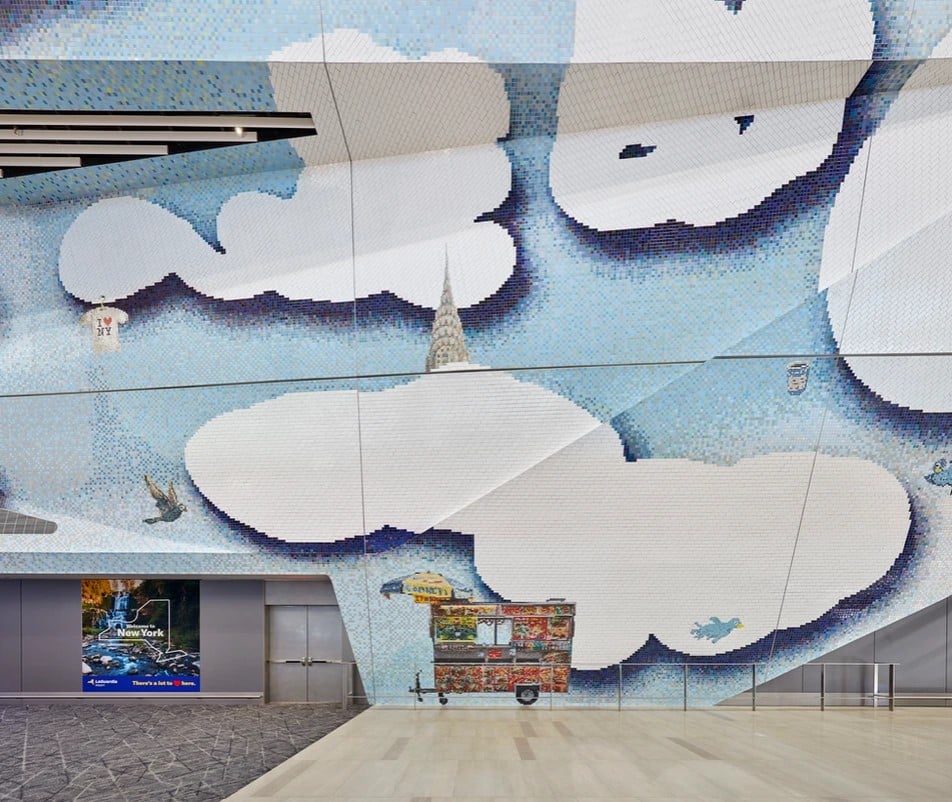
Laura Owens, I [Pizza Emoji] NY (2020). Photo: courtesy of Tom Powel Imaging/LaGuardia Airport.
Description of airport offerings: Artnet News in June 2022 covered the addition of $12 million worth of new art by leading artists including Mariam Ghani, Rashid Johnson, Aliza Nisenbaum, Virginia Overton, Ronny Quevedo, and Fred Wilson at the formerly decrepit transit hub’s remodeled Terminal C. But for this article, Artnet News has chosen to highlight works in the airport’s Terminal B, particularly a giant mosaic spanning two floors and made using handmade glazed ceramic tiles and grout.
The work shows a quintessential halal cart and ice cream truck in front of a blue sky with the Chrysler Building in the background with pizza slices, Metrocards, hot dogs and an I [Heart Emoji] NY shirt floating in the air. “Representing historic public artworks, treasured landmarks, popular snacks, and everyday sights, the mural also includes many symbols of the expansive transit network connecting them all,” a description of the mosaic reads. Other work in Terminal B includes, among others, All Your Wishes (2020), an installation of 70 mirror balloons made by artist Jeppe Hein from PVD-coated stainless steel and three modified social benches made from powder-coated aluminum that appear to float up to the ceiling.
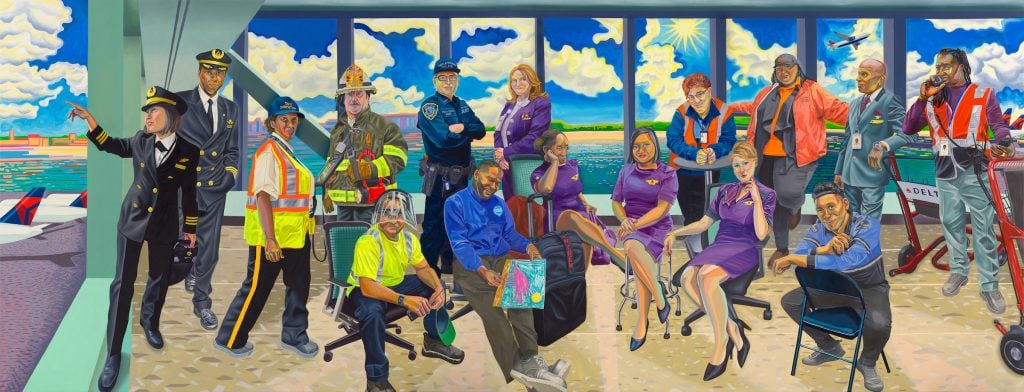
Aliza Nisenbaum, The Ones who Make it Run (Delta Terminal C, LaGuardia Airport). Photo: Courtesy of the Queens Museum.
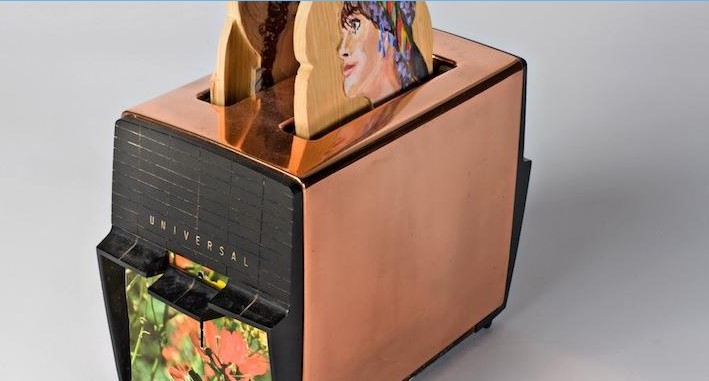
Katie Pell, Melanie Safka Commemorative-Toaster (2006). Photo: Courtesy of Houston Airports.
Main attraction: Extensive collection of small sculptures throughout the airport
Description of airport offerings: Artnet News could not pick out one particular piece of art above all others at IAH but has included the airport on this list because of its extensive collection of small and medium-sized sculptures in varying mediums and styles scattered throughout its terminals. Dozens of works are displayed ranging from abstract stoneware like Object PS-E by Jeff Forster to an animalian, mask-like bronze sculpture So by Ken Little. Its larger-scale works include Radiant Fountains, made of stainless steel and programmed LED lights, also by Dennis Oppenheim—who it turns out might be the most sought-after artist for airports. The oldest work in the IAH collection is West of the Pecos—made from steel beams painted construction yellow by Rolf Westphal.
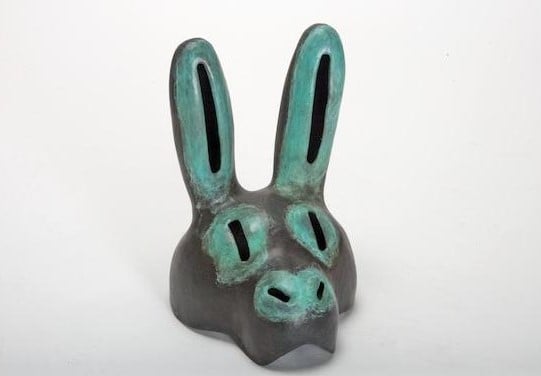
Ken Little, So (1996). Photo: Courtesy of Houston Airports.
This listing includes among the largest airports in the country, but smaller airports have also dedicated high dollars and energy to public art exhibits that are too exhaustive to list.
The airport in Birmingham, for example, has a notable Dada-inspired sculpture, Learning How to Ride My Grandfather’s Bike, and as I Grab Hold of The Handlebar, the Bike Turned Into A Raging Bull. Des Moines International Airport in Iowa in 2021 installed a 20-foot-tall sculpture by Alice Aycock—who has also made works for Philadelphia International Airport, Dulles International Airport, and the Kansas City International Airport. The pride of Harry Reid International Airport in Las Vegas is a sculpture titled Mirare in which two airplanes become visible when viewed from different angles. The airport also has numerous other mosaics and murals.